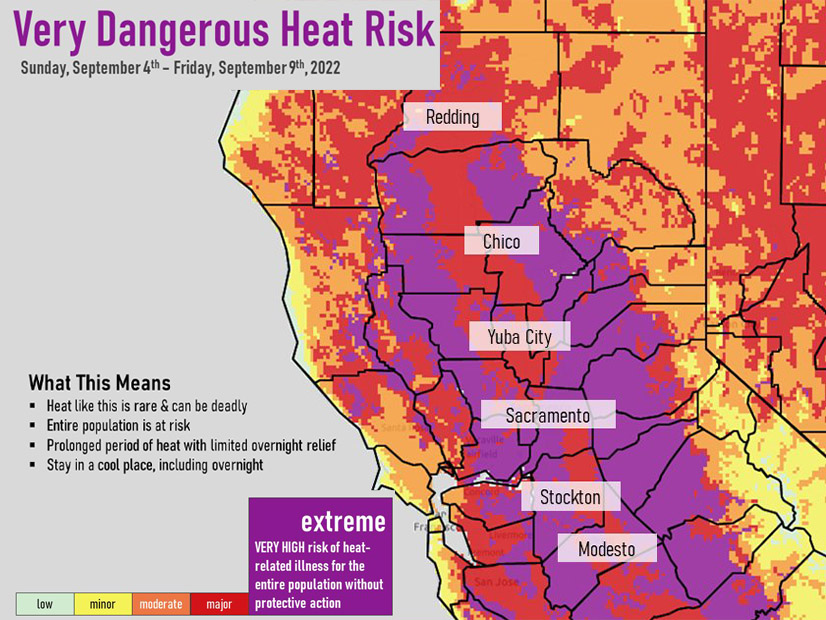
The National Weather Service predicts a record of high of 115 degrees Fahrenheit on Tuesday in the Sacramento Valley.
| National Weather ServiceCAISO CEO Elliot Mainzer said the state’s grid is facing its biggest challenge yet this summer as record temperatures bake large areas of California in a prolonged heat wave this week.
“This multiday event is going to get much more intense,” Mainzer said in a call with reporters Sunday. “We’re facing energy deficits between 2,000 to 4000 MW for tomorrow, and the highest likelihood of rotating outages that we’ve seen so far.
“As a result, we are going to need significant additional consumer demand reduction during the hours of 4 to 10 p.m. and access to all of the tools that the state and the utilities have established for conditions like this in order to avoid broader interruptions of service. So, it is game on and time for continued focus.”
The National Weather Service predicted high temperatures on Monday and Tuesday in the state’s Central Valley of up to 115 degrees Fahrenheit, a level of extreme heat more often associated with areas such as Death Valley. The forecast for Sacramento called for high temperatures on Monday of 112 F and 113 F on Tuesday.
In Southern California, home to 24 million residents, Downtown Los Angeles would see temperatures of over 100 degrees on Monday and again on Thursday, the weather service said.
Even San Francisco, normally cool in the summer, was expected to top out at 88 F on Monday and 87 F on Tuesday. The weather service said parts of the heavily populated San Francisco Bay Area would be much hotter, with some cities nearing 105 degrees.
The heat will continue throughout most of this week, the weather service said.
On Monday, CAISO issued a level 1 energy emergency alert (EEA), a signal that the “real-time analysis shows all resources are in use or committed for use, and energy deficiencies are expected. Market participants are encouraged to offer supplemental energy and ancillary service bids. Consumers are encouraged to conserve energy.”
CAISO is predicting demand of 51,145 MW on Tuesday. That would beat the record of 50,270 MW from July 2006.
Though several large fires were burning in Northern and Southern California, none had impacted the transmission system.
Mainzer said the ISO was monitoring for new wildfires with the potential to derate high-voltage lines and limit imported hydroelectricity from the Pacific Northwest, an essential supply source for California during summer months.
A massive wildfire in southern Oregon severely derated the Pacific AC and DC interties during a Western heat wave last July, shutting off power from hydroelectric dams in Washington and Oregon to California.
Extreme Weather
This week’s extended period of record heat is the latest in a series of extreme weather events that have troubled California and other areas of the West in recent years. A heat dome over the usually mild, rainy Pacific Northwest in June 2021 pushed temperatures to 115 F in Portland, Ore., and 107 F in Seattle, with some inland areas hitting 118 F.
West-wide heat waves and supply constraints struck the Western grid in August and September 2020, causing CAISO to order rolling blackouts in mid-August of that year and to declare energy emergencies over Labor Day weekend. The August blackouts affected more than 2 million residents for periods ranging from roughly 30 minutes to three hours.
Since then, CAISO has interconnected several thousand megawatts of lithium-ion batteries to its grid, almost all with four-hour discharge capabilities. The batteries are intended to make up for shortfalls during hot summer evenings and have performed according to expectations so far. How the batteries will perform in more extreme conditions is being tested this week.
Until now, California’s summer has been relatively mild this year with the exception of a less severe heat wave in mid-August, when CAISO issued a “flex alert” asking customers to reduce usage.
In anticipation of hotter weather this week, California Gov. Gavin Newsom on Wednesday proclaimed a state of emergency aimed at temporarily increasing energy production and reducing demand in response to an extreme heat wave forecast to hit the state this weekend. (See Newsom Declares Emergency as Heat Stresses Calif. Grid.)
Newsom’s emergency proclamation will allow gas-fired power plants to generate additional electricity by loosening air quality requirements and restrictions on fuel use. The proclamation relaxes restrictions on the use of backup generators from 2 to 10 p.m. on days in which CAISO has declared a level 2 or 3 EEA. Ships berthed at California ports also won’t be required to use shore power during such times.
“We are anticipating this extreme heat to be of a length and duration the likes of which we haven’t experienced in some time,” Newsom said in announcing the declaration.
